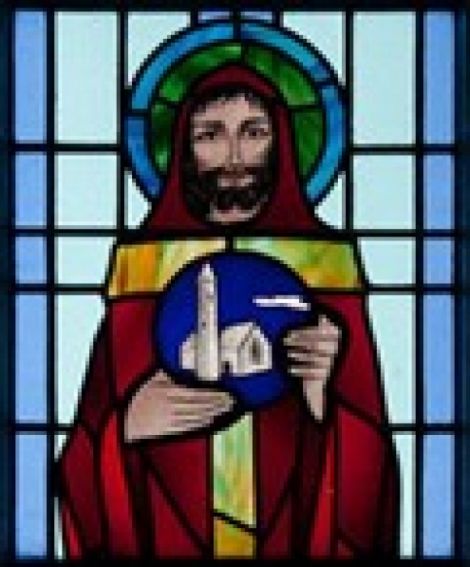Fact Sheet on Saint Benignus

Saint Benignus, Patron Saint of Balscadden National School
When the new Balscadden National School was officially opened on 26th February, 1986, Saint Benignus was re-dedicated as the patron saint of the school. Indeed no history of Balscadden is complete without the story of Saint Benignus. He was reputedly born in the Balscadden area. St Benignus died on 9th November, 467AD. The 9th of November is the day dedicated to the feast of St Benignus.
Saint Benignus meets St Patrick
When Saint Patrick first came to Ireland, he came to shore at the Delvin River. There he visited a local nobleman called Sesegne whom he baptised. St Patrick also baptised a little boy, son of Sesegne, whom he gave the name Benignus. It is said that Patrick baptised the boy in the River Delvin near the estuary with the sea. Shortly after the baptism, Patrick was worn out by all his travel on land and sea, and he fell asleep. The little boy gathered bunches of fragrant flowers and sweet smelling herbs and dropped them over the sleeping saint. The saint’s companions were just about to scold the young child when St Patrick awoke. St Patrick said: ‘Leave him so, he shall be the heir to my kingdom’. When Patrick died it was indeed Benignus who succeeded him as the ruler of the church in Ireland. In the meantime Benignus served as Patrick’s psalm singer and it was said that he had a wonderful singing voice as well as being an excellent student.
Ercuat falls in love with Benignus
St Benignus had one of the most beautiful singing voices in Ireland. Hence it came about that the beautiful daughter of King Daire fell deeply in love with him. Although she was not baptised, she listened to his sweet voice chanting in the choir and immediately fell in love with him. She did not have the courage to tell Benignus how she felt and eventually her heart broke with sadness and she died. Hearing what had happened St Benignus shook holy water on the princess and she miraculously came back to life. This was one of many miracles attributed to St Benignus. Ercuat spent the remainder of her days in holy life along with many of her companions.
St Benignus’ Death
St Benignus died on the 9th of November, 467AD.
St Benignus and the fire
In Easter 433AD St Patrick clashed with the High King of Ireland, King Laoghaire at Tara over religion. In order to settle the row a trial by fire was proposed. A pagan druid and Benignus were tied inside a burning timber building. The pagan druid was reduced to ash but Benignus was untouched by the fire. This was enough to convince the High King Laoghaire of the power of God and the teaching of Christianity began in Ireland.
St Benignus escapes death
One Easter Sunday Patrick and his followers, Benignus amongst them, were travelling on the road from Slane to Tara to visit King Laoghaire, High King of Ireland. King Laoghaire stationed soldiers to intercept them, because he did not want to hear what they had to say. Apparently, it was at that moment that a cloak of darkness descended over Patrick and his followers and not one of them appeared to the waiting soldiers. What the soldiers saw were eight deer going past them and behind them a fawn with a bundle on its back!
St. Benignus
One of the special features of the Tullamore Church of the Assumption is its stained glass windows from the Harry Clarke studios. Formerly situated in Rathfarnham castle, they were donated to the church by the Jesuits. These windows were removed from Rathfarnham castle in March of 1986 when the Jesuits decided to vacate the building.
The window above of Harry Clarke shows St. Benen or Benignus in Latin. He was a convert of St. Patrick, as was his family, but Patrick seemed to have made a particular impression on Benignus. Son of Sesegne, he was converted to Christianity while he was still a child.
In this window Benignus is holding a flame, symbolising the light of the gospel that Patrick brought to Ireland. He is also shown with a green circle around his head depicting his sainthood, and the fact that he was an Irish saint. The window also shows a green stole draped around his neck showing his priestly ministry. The artist also uses the traditionalist green colour in this window as in the window of Patrick, connecting the two as they were connected in real life. The feast day of St. Benignus in November 9th.

Balscadden NS, Balscadden, Ring Commons, Balbriggan, Co. Dublin 01-8412579

